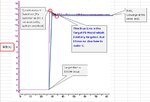lsh9640
Newbie level 2

Compute model :
Error = Target_Watt - Current_Watt
Current_Duty = Previous_Duty + GAIN * (Error)
→ I assume upper calculation is not a PI Modeling but it approximately work as PI control.
※ There are a couple of problems I face
1) Watt scale ( 0 ~ 10000 ) is different with Duty scale ( 0 ~ 1500 )
→ So, I Step down Watt scale by setting GAIN like 0.1 or 0.05 (Overshoot worsen if I raise this GAIN Value)
2) Duty is not proportional to Watt
→ Duty - Watt characteristic is some what complicated, Let me say, 20% IGBT Duty ON is good enough to saturate PTC(means there is less chance to increase current by increasing Duty), and 30% IGBT Duty ON will result in saturation(no more current even if applying more Duty on IGBT )
3) Internal resistor which affect current volume is constantly changed by internal temperature.
→ It is getting more complicated so, I simply disregard 2) 3) factors
Is there anyway to get better result like BLUE Line on the graph?
Could anyone give me some idea how to solve this problem?
Thanks.